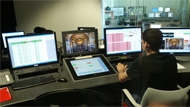Broadcast workflow, the Pharos approach

Workflow is a term that is used and abused. In an interview with Pharos Communications product manager Jason King, we explore how Pharos sees workflow and asset management being intimately linked in playout centers.
ATU: We understand that Pharos links workflow with asset management in playout centers.
JK: The Pharos approach to asset management allows broadcasters to expand their business in a rapidly developing but highly competitive market. We deliver these results using proven and fast file-based techniques that offer greatly enhanced efficiency and lower operating costs.
ATU: What architecture do you use?
JK: Complicated panel-per-product control hardware has no place in the modern broadcast environment. Pharos' core media asset management (MAM) system, Mediator, presents staff with easily understood graphic display screens providing the information needed to handle the current task. Irrelevant background information is hidden from non-engineering users but can easily be accessed by supervisors whenever required for reference, progress checking or reconfiguration.
ATU: This series is about workflow, how do you go about improving efficiencies?
JK: We have learned the importance of analyzing each MAM client's workflow to identify local requirements, to determine where existing practices can be improved and to flag single points of failure at the concept stage rather than waiting until system integration is near completion. This is often an illuminating procedure for the client because few broadcasters routinely analyze their own operational procedures.
Migrating from tape-based to a file-based broadcasting allows previously complex activity to be consolidated into a single workflow. Tapes can easily be lost or damaged, and the routines involved in moving discrete media from one location to another are unreliable and labor-intensive. Incoming content is automatically digitized on arrival. Accompanying metadata is simultaneously entered into the system and logged against the file throughout its life cycle.
Mediator allows files to be delivered directly onto the broadcast servers — no more tapes in the post. Files can be transcoded from one file type to another, simplifying the task of repackaging for Web-based and mobile television viewing, thus expanding a broadcaster's potential revenue streams.
ATU: You have talked about media files, what about the operators?
JK: Integral Web-based user interfaces allow ingest, quality-control/compliance and browsing/reviewing stations to be located anywhere on-site, off-site or offshore. Mediator connects disparate systems, enabling the current functions to be stretched. This includes scheduled import from third-party applications. Connecting to rights-management systems allows control of what is played to air. Editing systems are integrated into the workflow and alarms are raised when material is not yet ready for transmission.
ATU: As broadcasters consolidate into global media companies, what about scalability?
JK: We can manage every aspect of an end-to-end broadcast operation. An unlimited number of assets can be digitized and archived, allowing true migration from the tape library. Tape library shelf management, logging tools, ingest, quality control, automatic storage management and transfer facilities are all incorporated. Standard functions like searching the library and browsing are integral, and transcoding and re-wrapping can be added, allowing the passage of material between equipment with different file structures.
The value of a stored asset can also be increased by adding components such as extra audio tracks, languages, subtitles and audio description files. Archived content can be repurposed after use, removing the need for re-ingest. Repackaging program content to suit new markets and reformatting files to suit new delivery platforms are both far easier from a well-managed server-based system than from any manually controlled tape archive.
ATU: And who is using it?
JK: At Technicolor Network Services UK, part of the services division of Thomson, Pharos Mediator plays a central role providing workflow management, which integrates asset tracking, rules management, reporting and status. Mediator is used to implement workflow across the company's increasingly international and therefore multilanguage playout facility at Chiswick Park, London.
Also in London, Channel 4 Television recently chose Pharos Communications to provide the infrastructure for a major advance in the network's operations. Designated the Media Access Project, the new installation will center on Mediator and will enable Channel 4 to migrate from its tape-based library to file-based content archiving and access.
For more information, visit www.pharos-comms.com.
Get the TV Tech Newsletter
The professional video industry's #1 source for news, trends and product and tech information. Sign up below.
